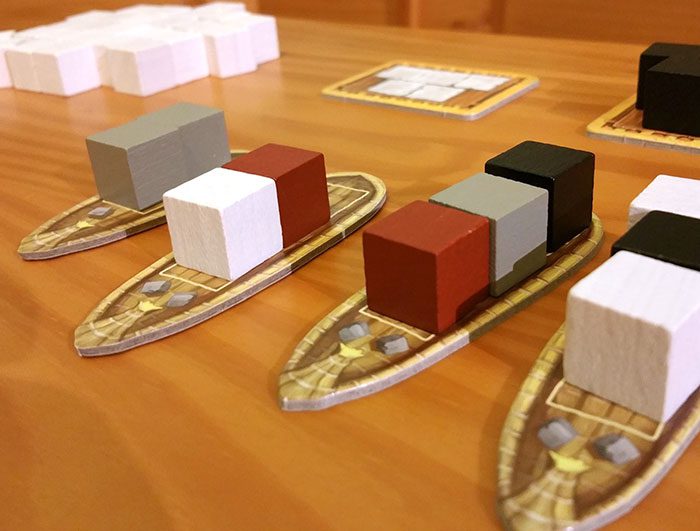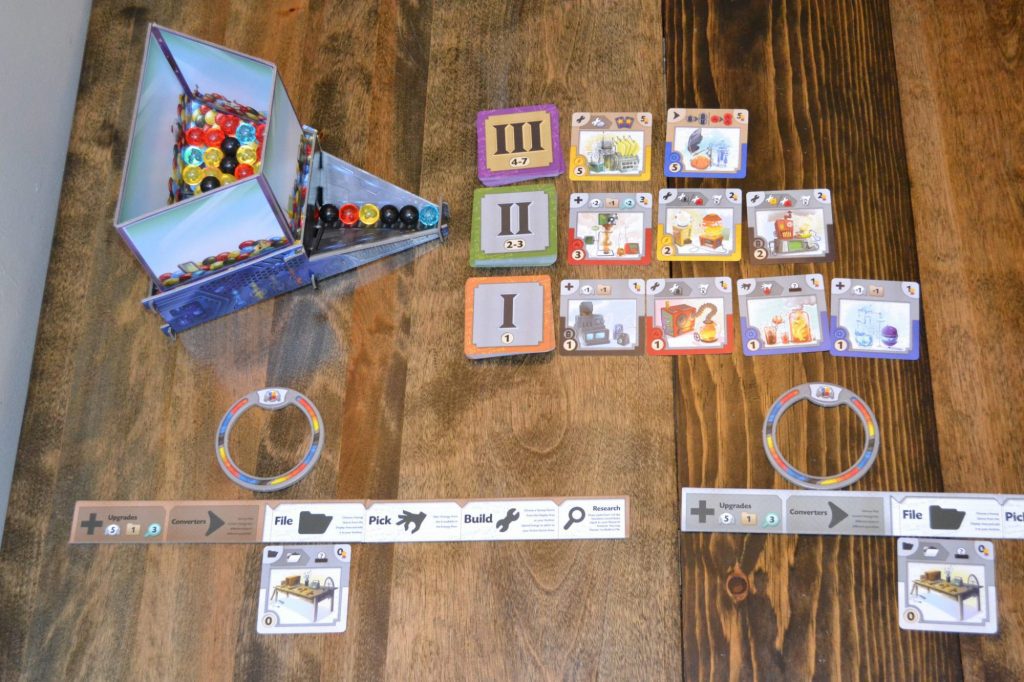Since then he’s designed his way across the globe…from South America with 2015’s Cacao and 2021’s Llamaland, to Egypt with the Spiel des Jahres nominated Imhotep in 2016, to a pirate’s deserted island in 2019’s Silver & Gold, and the landscapes of Norway with the redesign of the classic eurogame Fjords in 2022. He’s also taken us to the skies in 2020’s Cloud City, lakeside with 2021’s Summer Camp, and shown us his cultural side with 2022’s Museum Suspects.
To say that Phil Walker-Harding is a versatile designer would be an understatement. He’s designed simple set collection games which use only a deck of cards (Sushi Go!), to scripted “escape room” style games like 2019’s Adventure Games: The Dungeon, to elaborate cardboard contraptions like 2018’s Gizmos (with dozens of marbles and a hopper to hold them). While he’s mostly known for his strategy games, he also shows us he can cut loose with party games like 2021’s hidden role game Snakesss and the cooperative word guessing game Platypus.
You can read our 2017 interview with Phil Walker-Harding to find out what makes the man tick. But in the meantime, join us as we walk through what we consider to be the defining games of his portfolio: the essential Phil Walker Harding board game Collection.
Sushi Go
If you’ve played any of Phil Walker-Harding’s games it should come as no surprise that Sushi Go! / Sushi Go! Party appears at the top of this list. And indeed Sushi Go! is the most likely of his games that you might have played. It’s the quintessential title in his library and the scoring style would go on to inform many of his other designs, as well as the games of numerous other designers.
In Sushi Go! players attempt to earn the highest score by “picking and passing” (or drafting) cards. From their initial hand of cards, each player selects 1 card, then places it face down on the table. After all players have selected a card, each player flips their card over, then passes the remainder of their hand to the player on their left, receiving a hand of cards from the player on their right. Play continues until all cards have been flipped over, and then scoring occurs. Each card in Sushi Go! has a unique scoring condition which requires players to constantly be monitoring not only their own play area, but that of other players. Some cards score if the player has the most of that type, others score for sets of 2 or 3, others have a fixed point value, and still others increase in value for each additional card you add.

Sushi Go! Is a wonderful family game, with just enough strategy and uncertainty to keep things interesting. You can usually find Sushi Go! for $10 or so, but if you have the choice I’d suggest going for Sushi Go! Party, which is IMO the superior version. It contains everything from the base game, but expands the max player count from 5 to 8, gives you a scoreboard with player markers, includes additional cards in “special”, “appetizer”, “rolls”, and “dessert” cards (each of which have their own scoring methods), and provides a “menu” which recommends specific sets of cards to increase variety. The adorable “kawaii” style anthropomorphic sushi will immediately draw you in, and the clever gameplay will keep you engaged the entire game.
Read our review of Sushi Go! Party.
Bärenpark
2017 saw the release of what many consider to be their favorite PWH game, Bärenpark. It pits players against each other as rival architects and operators, trying to build homes for polar bears, panda bears, gobi bears, and koala bears. Released not too long after Cacao, Bärenpark added yet another tile-laying game to his portfolio. It also solidly extended his reach into that critical “family game” arena.
Bärenpark is a tile-laying polyomino game which means that throughout the course of the game you’re drafting tiles from a shared pool and placing them onto your board — think “flat Tetris” and you’re not too far off. But instead of solid colors, each tile you place into your park is an attraction that you want your park-goers to enjoy: from bathrooms, to concession stands, to lazy rivers, to playgrounds for the kids.
Each player starts with a single 4×4 park board and as you cover up various features on the main board with concession tiles you’ll unlock additional boards to expand the size of your park. But more importantly you’ll earn the privilege of adding a bear enclosure tile. These tiles are much larger and more oddly shaped which makes it both a challenge to place, and super satisfying when they are placed. Plus, the stacks of enclosure tiles decrease in value as more are taken. Once you place cover the last available space on each park board you’ll unlock a “bear statue” which can earn you as many as 16 points, and these decrease in value as more are taken and places as well.

Bärenpark has just enough thinkiness to be enjoyable, without making your brain melt. The artwork is adorable and full of details, and there’s just not that many other board games with bears out there…so you’ve got to grab them when you find them. Other than another player potentially taking a tile that you wanted, there’s no player interaction. That means you’re free to live your best life, raising bears and showing them off to eager bear aficionados.
Silver & Gold
Polyominoes have been making waves for the past few decades or so, starting with games like 1969’s Pentomino, 1980’s Quintillions, and of course the grandmaster of them all 1984’s Tetris. But modern games are leaning hard on polyominoes as well with 2000’s Blokus, 2014’s Patchwork, the previously mentioned Bärenpark in 2017, and dozens upon dozens of others. But in 2019 Phil combined polyominoes with the hugely popular roll and write genre to release 2019’s Silver & Gold; a “filp and fill” variant with a light pirate theme.
In Silver & Gold players draft “desert island” cards from a central tableau and attempt to find treasure by covering each island with polyomino shapes drawn from a shared “expedition” deck. This deck contains 8 cards displaying one of 6 different classic polyomino shapes. Players mark shapes directly onto their island cards, which are covered in a dry-erase finish. Once a card has been completely covered, players earn trophies, and draw a new card. In typical Phil fashion, certain spaces on each card contain various icons (good doubloons, palm trees, and “x marks the spot”) each of which provide valuable bonuses.

Silver & Gold is one of my favorite light games because it’s dead simple to teach and plays pretty quickly. Not to mention that when teaching the game to first-time players there’s a moment where they’re horrified to see me write directly onto the cards, followed by their gleeful faces when they do the same
But Silver & Gold is also one of my favorite Phil games because it shows a mastery of simplicity; at its core this game is just two decks of cards: the island deck and the shape deck, the score cards (1 for each player), the central round card, and some markers. Pretty sophisticated for a 20-minute card game right?
Read our review of Silver & Gold.
Imhotep
I played 2016’s Imhotep relatively early on in my journey in board gaming, and so the strategies it presented were novel to me, and I remember thinking to myself, “my choices are dizzying!”. Looking back I can smile with fond remembrance of my inexperience. But that doesn’t mean Imhotep falls flat when compared to newer games. In fact it still stands strong as an excellent strategy game for all ages.
In Imhotep, much like the game’s namesake, players act as royal builders to the pharaoh, attempting to construct the best monuments that will usher him into the afterlife. In practice this means you get to play with some of the coolest “cubes” in all of board gaming.

The goal of the game is to earn the most points, which are gained from the placement of blocks into one of 4 monument spaces (and a 5th market space where you can “sell” blocks to earn action cards). Each monument space has a unique scoring method, and timing for when players earn those points.
Imhotep is played over 6 rounds, and in each round players have only three actions: draw blocks from the quarry and place them on your sled, play blocks from your sled to one of the waiting barges, or sail a barge to a building site, and within each of these actions is a myriad of subtlety. But don’t be fooled, Imhotep is cutthroat, as players attempt to discern the choices of other players in order to decide their best move. Clearly a Phil classic…perhaps “dizzying” does still apply!
Cacao
Cacao has the distinction of being one of the first tile laying games I ever played; a mechanism which I’ve grown to love and contains notables like Fit to Print, Cascadia, and the grandmother of them all, Carcassonne.
In Cacao players act as South American tribes living in the Amazon jungles and harvesting “the fruit of the gods”, cacao. Over the course of the game players place jungle tiles, collect water, harvest and sell cacao pods, and worship at their temples.
Cacao also has a light worker placement aspect, with each tile displaying a number of workers on each edge. When a player’s worker tile is placed against a jungle tile, that player is able to take that action a number of times based on how many workers are touching it. You might be able to harvest cacao, then turn around and sell them for gold, all in the same turn.
The design of Cacao is really elegant: it’s easy to teach, finishes in 30-45 minutes, and is a great gateway game.
Gizmos
When it comes to Phil Walker-Harding games with “table presence”, the 2018 release Gizmos owns every other game in his collection. The main focus of Gizmos is a three dimensional cardboard contraption whose sole job is to funnel out multi-colored marbles for players.
The goal of Gizmos is to be the inventor with the most points, which are earned by building “gizmos” of ever-increasing complexity and usefulness. Players have a number of actions they can perform on their turn, all dictated by the gizmos in front of them. Some gizmos allow you to pull marbles from the hopper, some gizmos allow you to draw or build other gizmos, while other gizmos allow you to store more marbles in your workbench, or even convert one color of marble to another.

Gizmos is an “engine building game,” which means that as you collect and build gizmos your capabilities both increase and improve. You can chain gizmos together in elaborately combined ways to accomplish your plans, namely to win the game.
Gizmos isn’t Phil’s most popular game, but it is perhaps one of his most ambitious and satisfying.
Snakesss
The 2021 release Snakesss was Phil’s first pure party game; a combination of trivia, hidden roles, guessing, and bluffing wrapped up in a 20-30 minute play time. Players are a mix of humans, mongoose, and snakes, each with their own slightly different play styles.
Each round the role cards are shuffled and passed out, and a multiple-choice trivia card is displayed. The snake players are given access to the correct answer and their job is to mislead the human players into guessing incorrectly. The mongoose player reveals themself at the beginning of the round and they act as a “trusted player”. Humans and mongoose earn points if they guess the correct answer, while snakes earn points for each incorrect guess by other players.
Snakesss plays up to 8, and is an excellent game to include in any collection.
Adventure Games: The Dungeon
Phil’s 2019’s title Adventure Games: The Dungeon was his attempt to mix a one-shot mystery (ala the Exit and Unlock series) with the smash hit books Choose Your Own Adventure. This title offers 3 “sub games”, or chapters, each of which lead players deeper into the dungeon and closer to victory.
What makes Adventure Games: The Dungeon unique is that players can combine anything featured on one of the current cards in their dungeon to reveal a 6-digit code. Looking that code up in the back of the book, or on the accompanying app, will let players know if they’re on the right track. It’s a marvelous exploration of magic, fantasy, and sinister evil, and is a good time for all involved.
After completing The Dungeon, players can explore other settings with Volcanic Island, Gloom City, The Grand Hotel Abaddon, or Monochrome, Inc.
Read our review of Adventure Games: The Dungeon.
In Conclusion
Thanks for taking this journey with me through the standout games in Phil’s collection. Remember that this is by no means complete, and doesn’t touch on many of his newer titles. He even started his own publishing house, Joey Games, in order to release kid-friendly titles in his native Australia with an eye towards improving the ecological impact of the game publishing industry. I think you might agree that Phil has become a powerhouse in the game design industry and I hope he releases many more titles in the years to come.



















Personally, I love Gizmos. It’s a mainstay at my table. It’s a quirky but great engine builder. I love a good game that gives me something besides meeples, cards, and polyominoes.